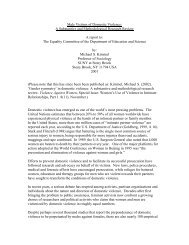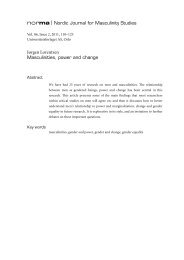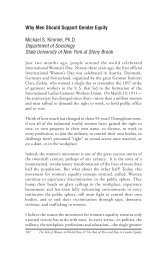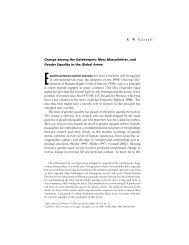Boys, Sex, and Porn: New technologies and old dangers - XY online
Boys, Sex, and Porn: New technologies and old dangers - XY online
Boys, Sex, and Porn: New technologies and old dangers - XY online
You also want an ePaper? Increase the reach of your titles
YUMPU automatically turns print PDFs into web optimized ePapers that Google loves.
Public concerns about young people’s exposure to pornography have been prompted in part by six<br />
shifts in young people’s sexual lives over the last few decades.<br />
Other shifts in the sexual lives of young people<br />
First, children in Western countries are now starting puberty <strong>and</strong> adolescence earlier <strong>and</strong> staying in<br />
it for longer than ever before. Second, the average age of first intercourse has declined. Third,<br />
younger people engage in a wider variety of sexual behaviours than <strong>old</strong>er people, including oral sex<br />
<strong>and</strong> anal intercourse. Fourth, young people now have a greater number of sexual partners. Fifth,<br />
some young people are participating in an increasingly visible gay <strong>and</strong> lesbian community, <strong>and</strong> from<br />
Australian studies, about one in ten secondary school students is sexually attracted either to the same<br />
sex only or to both sexes. Finally, today’s children are growing up in a sexualised cultural<br />
environment. Late twentieth-century Western cultures saw a proliferation of sexual imagery <strong>and</strong> an<br />
explosion of popular sexual debate.<br />
<strong>Sex</strong>ualisation of contemporary culture. Media’s role in (informal) sexuality education.<br />
Today’s children are growing up in a very different cultural environment: sexual imagery is more<br />
common <strong>and</strong> sex is part of popular discussion.<br />
The mass media plays a powerful role in the socialisation of children <strong>and</strong> adolescents (G<strong>old</strong>man<br />
2000, p. 16). In fact, the media may be particularly important in shaping young people’s sexual<br />
knowledge, attitudes, <strong>and</strong> behaviours in that they have limited access to other sources of sexual<br />
information. Parents seldom provide detailed information <strong>and</strong> communicate about sexuality-related<br />
topics only with difficulty, while school sexuality education often focuses on biology <strong>and</strong> neglects<br />
sexual behaviour, romance <strong>and</strong> interpersonal relations.<br />
Given the increasing sexualisation or ‘pornographication’ of mainstream media, X-rated movies <strong>and</strong><br />
‘adult’ websites are hardly the only sources of young people’s encounters with sexually explicit<br />
representations. Still, I focus on pornography because it is at the centre of contemporary debates<br />
regarding youth <strong>and</strong> sexually explicit representations.<br />
So, what is pornography?<br />
What is pornography?<br />
<strong>Porn</strong>ography can be defined as ‘sexually explicit media that are primarily intended to sexually<br />
arouse the audience’ (Malamuth 2001, p. 11817). ‘<strong>Sex</strong>ually explicit’ representations include images<br />
of female or male nudity or semi-nudity, implied sexual activity, <strong>and</strong> actual sexual activity.<br />
I use the term ‘pornography’ as a neutral term, rather than as a negative term referring to<br />
representations of bodies <strong>and</strong> sexual activity which are offensive, obscene, or harmful.<br />
2. Exposure of youth to pornography<br />
2.1 Paths to exposure<br />
How are children <strong>and</strong> young people exposed to pornography?<br />
First, children may deliberately seek sexually explicit materials. They do this for reasons which<br />
overlap with those of adults: curiosity, interest in sexual <strong>and</strong> reproductive health, interest in<br />
2
















